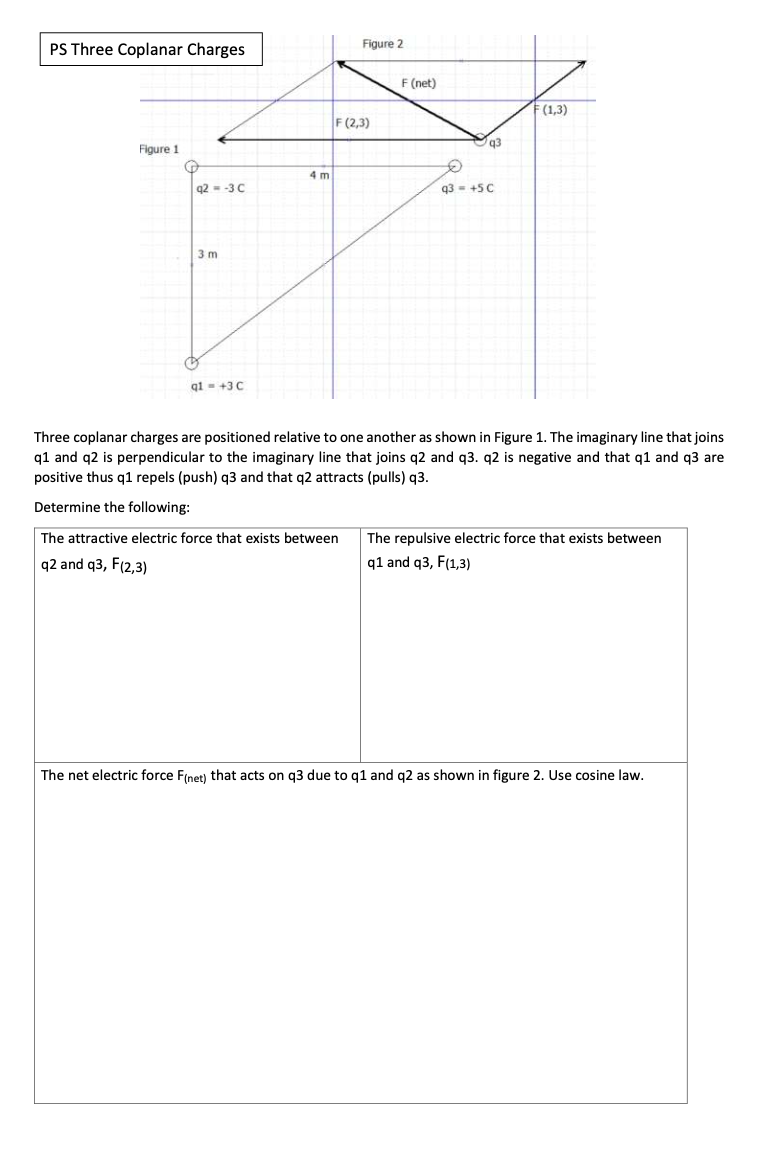PS Three Coplanar Charges Figure 2 F (net) F(1,3) F (2,3) Figure 1 4 m q2 - -3C q3 - +5C 3 m qi - +3C Three coplanar charges are positioned relative to one another as shown in Figure 1. The imaginary line that joins q1 and q2 is perpendicular to the imaginary line that joins q2 and q3. q2 is negative and that q1 and q3 are positive thus q1 repels (push) q3 and that q2 attracts (pulls) q3. Determine the following: The attractive electric force that exists between The repulsive electric force that exists between q2 and q3, F(2,3) q1 and q3, F(1,3) The net electric force F(net) that acts on q3 due to q1 and q2 as shown in figure 2. Use cosine law.
PS Three Coplanar Charges Figure 2 F (net) F(1,3) F (2,3) Figure 1 4 m q2 - -3C q3 - +5C 3 m qi - +3C Three coplanar charges are positioned relative to one another as shown in Figure 1. The imaginary line that joins q1 and q2 is perpendicular to the imaginary line that joins q2 and q3. q2 is negative and that q1 and q3 are positive thus q1 repels (push) q3 and that q2 attracts (pulls) q3. Determine the following: The attractive electric force that exists between The repulsive electric force that exists between q2 and q3, F(2,3) q1 and q3, F(1,3) The net electric force F(net) that acts on q3 due to q1 and q2 as shown in figure 2. Use cosine law.
Physics for Scientists and Engineers, Technology Update (No access codes included)
9th Edition
ISBN:9781305116399
Author:Raymond A. Serway, John W. Jewett
Publisher:Raymond A. Serway, John W. Jewett
Chapter23: Electric Fields
Section: Chapter Questions
Problem 23.30P: Three charged particles are at the corners of an equilateral triangle as shown in Figure P23.15. (a)...
Related questions
Question
Please answer the following questions with answers

Transcribed Image Text:PS Three Coplanar Charges
Figure 2
F (net)
E(1,3)
F (2,3)
q3
Figure 1
4 m
q2 = -3 C
93 - +5C
3 m
qi = +3 C
Three coplanar charges are positioned relative to one another as shown in Figure 1. The imaginary line that joins
q1 and q2 is perpendicular to the imaginary line that joins q2 and q3. q2 is negative and that q1 and q3 are
positive thus q1 repels (push) q3 and that q2 attracts (pulls) q3.
Determine the following:
The attractive electric force that exists between
The repulsive electric force that exists between
q2 and q3, F(2,3)
q1 and q3, F(1,3)
The net electric force Finer) that acts on q3 due to g1 and g2 as shown in figure 2. Use cosine law.
Expert Solution
This question has been solved!
Explore an expertly crafted, step-by-step solution for a thorough understanding of key concepts.
This is a popular solution!
Trending now
This is a popular solution!
Step by step
Solved in 3 steps with 3 images

Follow-up Questions
Read through expert solutions to related follow-up questions below.
Follow-up Question
Hwo about the 5C? Why did it not change to negative?
Solution
Follow-up Question
Why did you use q2 as positive 3 instead of negative given that the original value of it is negative
Solution
Knowledge Booster
Learn more about
Need a deep-dive on the concept behind this application? Look no further. Learn more about this topic, physics and related others by exploring similar questions and additional content below.Recommended textbooks for you

Physics for Scientists and Engineers, Technology …
Physics
ISBN:
9781305116399
Author:
Raymond A. Serway, John W. Jewett
Publisher:
Cengage Learning

Principles of Physics: A Calculus-Based Text
Physics
ISBN:
9781133104261
Author:
Raymond A. Serway, John W. Jewett
Publisher:
Cengage Learning

Physics for Scientists and Engineers with Modern …
Physics
ISBN:
9781337553292
Author:
Raymond A. Serway, John W. Jewett
Publisher:
Cengage Learning

Physics for Scientists and Engineers, Technology …
Physics
ISBN:
9781305116399
Author:
Raymond A. Serway, John W. Jewett
Publisher:
Cengage Learning

Principles of Physics: A Calculus-Based Text
Physics
ISBN:
9781133104261
Author:
Raymond A. Serway, John W. Jewett
Publisher:
Cengage Learning

Physics for Scientists and Engineers with Modern …
Physics
ISBN:
9781337553292
Author:
Raymond A. Serway, John W. Jewett
Publisher:
Cengage Learning

Physics for Scientists and Engineers
Physics
ISBN:
9781337553278
Author:
Raymond A. Serway, John W. Jewett
Publisher:
Cengage Learning

College Physics
Physics
ISBN:
9781938168000
Author:
Paul Peter Urone, Roger Hinrichs
Publisher:
OpenStax College

College Physics
Physics
ISBN:
9781305952300
Author:
Raymond A. Serway, Chris Vuille
Publisher:
Cengage Learning